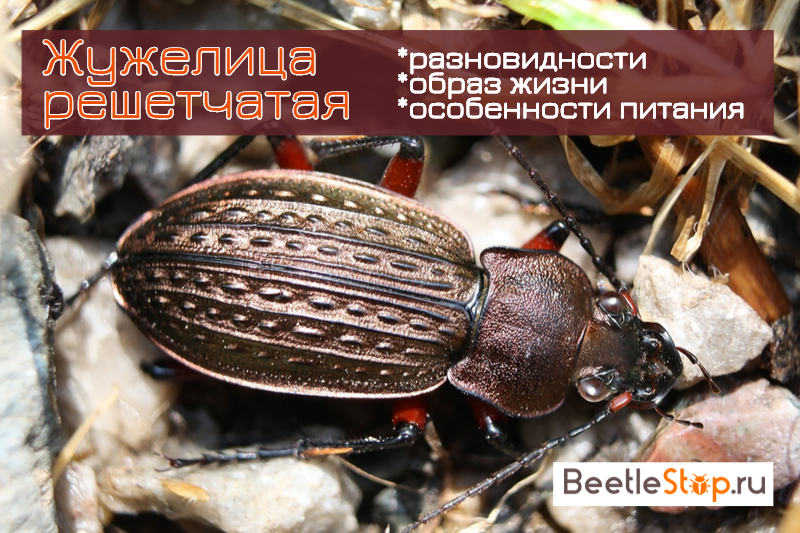Ground beetle - predator without food specialization
Ground beetles are a large family of beetles. It already has 25-50 thousand species, but scientists regularly find undescribed groups of insects. Beetles of various species are similar to each other. They have a dark color, the characteristic shape of the pronotum, relief elytra. The ground beetle is a typical nocturnal predator. She attacks slugs, earthworms. During the breeding season, the beetle is active at any time of the day.

Morphological description of the species
Ground beetle lattice or copper (Carabus cancellatus) belongs to the order Coleoptera, the family of ground beetles, the genus Carabus. The length of the imago is 20-28 mm. The body is elongated. The upper side is copper or bronze with a distinct metallic tint. Sometimes individuals of dark green or bronze-black color are found. The lower body is black, shiny. Most beetles have bright red hips; one of the synonyms for ground beetle is red-legged. In front of the apex of the elytra of the female, a noticeable notch; in the male, it is much smaller. Convex elytra covered with a peculiar pattern of longitudinal carinae and rows of tubercles between them. Elytra fused in the middle, wings reduced.
The head is directed forward, slightly retracted into the prothorax. The area behind the temples is narrowed, looks like a neck. Mandibles are crescent, pointed. Their purpose is to seize and hold the victim. The eyes are large, convex. There are no simple eyes. Antennae are filiform, composed of 11 segments. The first is red, the rest are black. On top of each segment is a bundle of black hairs. The forehead and clypeus are almost horizontal. The margins of the pronotum are bordered by a black edging, the lateral parts are elevated. The limbs are long, designed for walking and fast running. In males, the front legs are flat and wide. Abdomen with eight sternites.
Subspecies
There are 9 subspecies of the species Carabus cancellatus, they differ in shades of color, head width, elytra and limb sizes.
- C. c. carinatus;
- C. c. tuberculatus;
- C. c. alessiensis;
- C. c. tibiscinus;
- C. c. cancellatus;
- C. c. excisus;
- C. c. corpulentus;
- C. c. emarginatus;
- C. c. graniger.
Lifestyle
Copper ground beetle lives in coniferous and broad-leaved forests, in grass-meadow meadows. Insects select plots with a lot of fallen leaves and plant debris. In their biocenosis, they regulate the number of invertebrate animals. Activity time from April to September. Beetles do not fly, they hunt on the surface of the soil at night. Daytime hours are spent hiding in forest litter.
Eat slugs, insects, earthworms, caterpillars, and grub. Sharp strong jaws easily tear open the covers of their victims. Adults do not give up the sweet juice of ripe berries. Ground beetles are not picky about food. Adults and larvae eat invertebrates of any species. The exception is hairy caterpillars. Beetles feed not only on live prey, they feed on found vertebrate corpses.
Information. A vital factor for the development of ground beetles is soil moisture.
Breeding
The breeding season of ground beetles occurs at the end of a vein or the beginning of summer. Fertilized females lay their eggs in June. They hide masonry under the leaves or in the upper layers of the soil. After 2 weeks, the larvae of the campodeoid form appear, they look like a two-tailed. The body is slim, long.The color is black. The head is wide, flattened, well isolated. The upper lip is absent. Antennae composed of 4 segments, attached at the base of the mandibles. The inner edge of the mandibles with a tooth. Three pairs of short legs, consisting of 5 parts, are attached to the chest. Foot with two claws. Abdomen of 10 segments. There are 8 pairs of spiracles. On the 9th segment there are churches.
Larvae have more enemies than adult insects. They develop and hunt in the litter and the upper layers of the soil, being multi-eating predators. Larvae are vigorous and voracious; they destroy numerous offspring of invertebrates.
Pupation begins in August. The cradle settles down under a stone, moss or leaves. Pupa is light, parts of the body are clearly distinguishable. Before the transformation begins, it darkens. Young adults appear in autumn, do not show activity and remain wintering. From under the forest litter, they will appear in April to give life to the next generation.
Habitat
Ground beetle lives in Northern and Central Europe. In Russia, it occurs before Western Siberia, Lake Baikal and Yakutia. The insect is artificially brought to the USA.
Digestion
Adult individuals and larvae of ground beetles are distinguished by extraintestinal digestion. Insects do not have salivary glands to wet and dissolve food. Instead of gastric juice, beetles have a secretion of the middle intestine, released out through special channels. It softens areas of the prey's body, turning them into a jelly-like substance absorbed by the beetle. Strong mandibles are used only for food retention.
Interesting fact. Ground beetles of copper and other representatives of the predatory family are bred in insectariums.
Insect protection
In some places, the species Carabus cancellatus is found in large quantities. In other regions, its numbers are declining. the main reason for the death of beetles is human economic activity. When treating fields with chemicals, not only pests, but beneficial insects die. Limiting factors are:
- fragmentation of habitats;
- difficulties with the migration of flightless insects;
- reduction in the area of natural biocenoses;
- bollards and continuous mowing of grass.
The species is listed in the Red Book of the Republic of Belarus (II category). In Russia it is protected in the territory of the Astrakhan region and Moscow. To preserve the red-legged ground beetle, landscape reserves are being created in the Russian capital. They include biotopes with beetles. In LZ it is forbidden to turn meadows into lawns. Forged areas restored forbs. Strengthens control over spring arson of grass.


